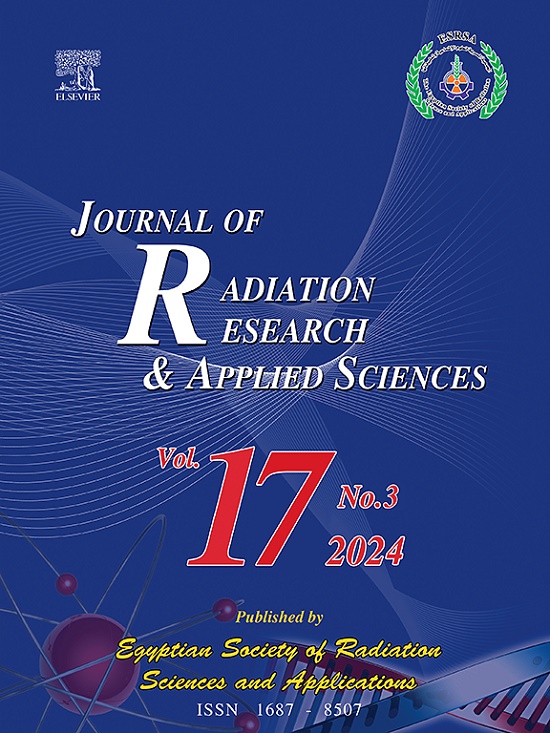评估沙特放射科医生在阅读筛查乳房x光检查中的表现
IF 1.7
4区 综合性期刊
Q2 MULTIDISCIPLINARY SCIENCES
Journal of Radiation Research and Applied Sciences
Pub Date : 2025-05-09
DOI:10.1016/j.jrras.2025.101568
引用次数: 0
摘要
目的评价沙特放射科医生在解释筛查性乳房x线照片方面的诊断表现。方法共有72名读者参与,其中沙特人33名,非沙特人39名。参与者使用DetectedX在线平台解读了30张乳房x光片(15张正常,15张异常)。对于每个参与者,收集关键绩效指标,包括敏感性、特异性和病变敏感性。此外,病变检测性能评估与刀自由反应接收器工作特性(JAFROC)优点图(FOM)。分析探讨了性能指标和关键读者特征之间的关系。结果非沙特放射科医师的JAFROC评分(中位数= 0.53 vs. 0.43, p = 0.043)和特异性(中位数= 0.80 vs. 0.55, p <;0.001),与沙特的放射科医生相比。然而,沙特的放射科医生表现出更高的敏感性(中位数= 0.80 vs. 0.60, p = 0.024)。在JAFROC模型中,国籍是一个显著的预测因子,非沙特人得分高于沙特人(R2 = 10.2%, p = 0.04),而在敏感性模型中,沙特人优于非沙特人(R2 = 7.4%, p = 0.02)。病变敏感性可由体位预测(R2 = 15.2%),特异性模型可解释体位和国籍的最高方差(R2 = 44.7%)。结论沙特放射科医师对乳腺癌的检测能力较强,但其特异性较低,需要提高诊断准确性以减少假阳性。为了提高乳腺癌筛查的整体诊断准确性,必须实施有针对性的专业发展计划,重点是平衡敏感性和特异性。本文章由计算机程序翻译,如有差异,请以英文原文为准。
Assessmentof saudi radiologist performance in reading screening mammography
Aim
To evaluate the diagnostic performance of Saudi radiologists in interpreting screening mammograms.
Methods
A total of 72 readers participated, including 33 Saudis and 39 non-Saudis. Participants interpreted 30 mammograms (15 normal and 15 abnormal) using the DetectedX online platform. For each participant, key performance metrics were collected, including sensitivity, specificity, and lesion sensitivity. In addition, lesion detection performance was assessed with the Jackknife Free-Response Receiver Operating Characteristics (JAFROC) Figure of Merit (FOM). The analysis explored the relationship between performance metrics and key reader characteristics.
Results
Non-Saudi radiologists demonstrated significantly higher JAFROC scores (median = 0.53 vs. 0.43, p = 0.043) and specificity (median = 0.80 vs. 0.55, p < 0.001) compared to Saudi radiologists. However, Saudi radiologists showed higher sensitivity (median = 0.80 vs. 0.60, p = 0.024). In the JAFROC model, nationality was a significant predictor, with non-Saudis scoring higher than Saudis (R2 = 10.2 %, p = 0.04), whereas in the sensitivity model, Saudis outperformed non-Saudis (R2 = 7.4 %, p = 0.02). Lesion sensitivity was predicted by position (R2 = 15.2 %), while the specificity model explained the highest variance (R2 = 44.7 %) based on both position and nationality.
Conclusion
While Saudi radiologists showed strong abilities in detecting breast cancer, their lower specificity highlights the need for improving diagnostic accuracy to reduce false positives. To enhance overall diagnostic accuracy in breast cancer screening, it is essential to implement targeted professional development programs focusing on balancing sensitivity and specificity.
求助全文
通过发布文献求助,成功后即可免费获取论文全文。
去求助
来源期刊

Journal of Radiation Research and Applied Sciences
MULTIDISCIPLINARY SCIENCES-
自引率
5.90%
发文量
130
审稿时长
16 weeks
期刊介绍:
Journal of Radiation Research and Applied Sciences provides a high quality medium for the publication of substantial, original and scientific and technological papers on the development and applications of nuclear, radiation and isotopes in biology, medicine, drugs, biochemistry, microbiology, agriculture, entomology, food technology, chemistry, physics, solid states, engineering, environmental and applied sciences.
 求助内容:
求助内容: 应助结果提醒方式:
应助结果提醒方式:


